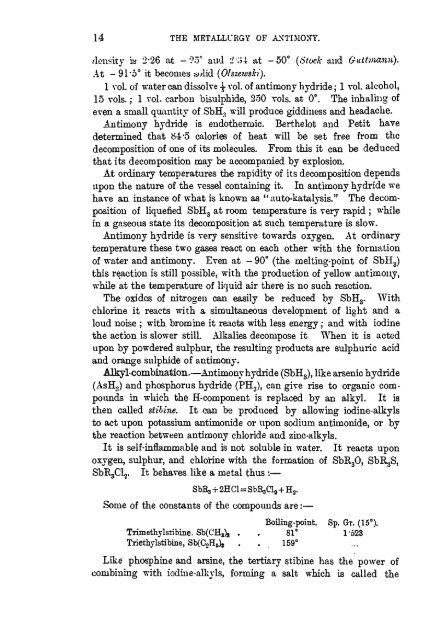antimony - Sciencemadness.org
antimony - Sciencemadness.org
antimony - Sciencemadness.org
You also want an ePaper? Increase the reach of your titles
YUMPU automatically turns print PDFs into web optimized ePapers that Google loves.
14 THE METALLURGY OF ANTIMONY.<br />
density is 2*26 at - 25 C and iKU at -50° (Stock and Guttoriann).<br />
At - 91*5° it becomes sulid (Ohzewski).<br />
1 vol. of water can dissolve \ vol. of <strong>antimony</strong> hydride; 1 vol. alcohol,<br />
15 vols.; 1 vol. carbon bisulphide, 250 vols. at 0°. The inhaling of<br />
even a small quantity of SbH3 will produce giddiness and headache.<br />
Antimony hydride is endotheruiic. Berthelot and Petit have<br />
determined that 84*5 calories of heat will be set free from the<br />
decomposition of one of its molecules. From this it can be deduced<br />
that its decomposition may be accompanied by explosion.<br />
At ordinary temperatures the rapidity of its decomposition depends<br />
upon the nature of the vessel containing it. In <strong>antimony</strong> hydride we<br />
have an instance of what is known as "auto-katalysis." The decomposition<br />
of liquefied SbH3 at room temperature is very rapid; while<br />
in a gaseous state its decomposition at such temperature is slow.<br />
Antimony hydride is very sensitive towards oxygen. At ordinary<br />
temperature these two gases react on each other with the formation<br />
of water and <strong>antimony</strong>. Even at - 90° (the melting-point of SbH3)<br />
this reaction is still possible, with the production of yellow <strong>antimony</strong>,<br />
while at the temperature of liquid air there is no such reaction.<br />
The oxides of nitrogen can easily be reduced by SbH3. With<br />
chlorine it reacts with a simultaneous development of light and a<br />
loud noise ; with bromine it reacts with less energy; and with iodine<br />
the action is slower still. Alkalies decompose it. When it is acted<br />
upon by powdered sulphur, the resulting products are sulphuric acid<br />
and orange sulphide of <strong>antimony</strong>.<br />
Alkyl-combination.—Antimony hydride (SbH3), like arsenic hydride<br />
(AsH3) and phosphorus hydride (PH3), can give rise to <strong>org</strong>anic compounds<br />
in which the H-component is replaced by an alkyl. It is<br />
then called stibine. It can be produced by allowing iodine-alkyls<br />
to act upon potassium antimonide or upon sodium antimonide, or by<br />
the reaction between <strong>antimony</strong> chloride and zinc-alkyls.<br />
It is self-inflammable and is not soluble in water. It reacts upon<br />
oxygen, sulphur, and chlorine with the formation of SbR3O, SbR3S,<br />
RCL It behaves like a metal thus :—<br />
SbRj + 2HC1 = SbRjCla + H2.<br />
Some of the constants of the compounds are:<br />
Trimethylstibine. Sb(CH3), .<br />
Triethylstibine, Sb(C2H5)3<br />
.<br />
Boiling-point.<br />
81°<br />
. . 159°<br />
Sp. Gr. (15°).<br />
1-523<br />
Like phosphine and arsine, the tertiary stibine has the power of<br />
combining with iodine-alkyls, forming a salt which is called the
















